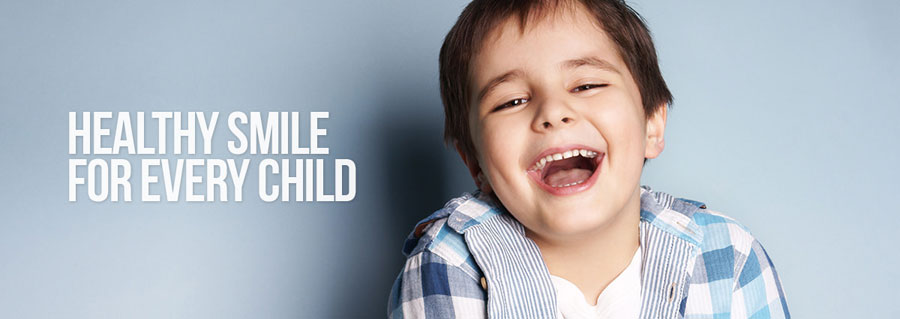Remember when children kicked and screamed their way to the dentist? Well not anymore! At our Center, we take utmost care not to rush and hurry the child and explain the procedure in a child friendly manner. This helps in instilling a positive dental attitude so that your child leaves our clinic with a smile!
We give a special emphasis on child psychology, growth and development. Infants, preschoolers, children, and adolescents each need a different approach in dealing with their behaviour, guiding their dental growth and development, and helping them avoid future dental problems.
Most adults who are poor dental patients might have had a traumatic dental experience during their childhood.
FAQ’S
When should my child first see a dentist?
It is recommended that your child should visit the dentist by his or her 2nd birthday. Early examination and preventive care will protect your child’s smile now and in the future. Most of the children who have regular dental visits from infancy remain caries free (decay free) throughout their lifetime.
We provide children (also their parents) with information regarding prevention of dental caries, oral hygiene measures and other common oral problems thereby helping them achieve a smooth transition from milk teeth to an ideal set of permanent teeth.
Why spend on the maintenance of milk teeth when they are to be finally replaced by the permanent ones?
- The baby teeth help in chewing and digestion - physical and partial chemical digestion before the food is chemically digested by the gastric juices.
- The baby teeth are necessary for speech development e.g. the words th, f, and lisping sounds require front teeth to pronounce.
- Building the Childs confidence. The baby teeth help in appearance or aesthetics. Without the front teeth, peers, leading to reluctance to smile, mix with others and make new friends, could tease the child.
- Probably the most important function of the baby teeth is to maintain sufficient space for the adult (permanent) teeth to erupt into the correct position. The first adult tooth (first molar teeth) starts developing when the fetus is 7-8 months in utero (in the mother's womb) and will continue to develop as the child grows. It finally erupts in the mouth from the age of 6. The primary teeth are therefore very necessary in guiding these adult teeth into the correct straight position.
Some of the ways to protect your childrens teeth from decay are-
- Regular cleanings with fluoride application
- Dental Sealants
Pit and Fissure sealants:
What are Sealants?
Sealants are liquid coatings that harden on the chewing surfaces of teeth.
Why do I need Sealants?
They show a great deal of effectiveness in preventing cavities. The pits and grooves of your teeth are prime areas for opportunistic decay. Even regular brushing sometimes misses these intricate structures on the chewing surfaces of your teeth. The sealants are applied to the chewing surfaces and are designed to prevent the intrusion of bacteria and other debris into the deep crevices on the tops of teeth.
At what age can I get sealants?
Young children between the age of 6 and 11 are the best candidates for preventative measures like sealants (especially on molars) because in many cases, decay has not set in. Even on teeth where decay is present, sealants have been shown to fight additional damage.
Flouride Application-
What Is Fluoride Varnish?
Fluoride varnish is a dental treatment that can help prevent tooth decay, slow it down, or stop it from getting worse. Fluoride varnish is made with fluoride. Fluoride is absorbed into the teeth, making them stronger and more resistant to fractures and decay. A process in your body called “remineralization” uses fluoride to repair damage caused by decay.
Keep in mind that fluoride varnish treatments cannot completely prevent cavities. Fluoride varnish treatments can best help prevent decay when a child is also brushing using the right amount of toothpaste with fluoride, flossing regularly, getting regular dental care, and eating a healthy diet.
Is Fluoride Varnish Safe?
Fluoride varnish is safe and used by dentists and doctors all over the world to help prevent tooth decay in children. Only a small amount is used, and hardly any fluoride is swallowed. It is quickly applied and hardens. Then it is brushed off after 4 to 12 hours.
How is Fluoride Varnish Put on the Teeth?
Fluoride varnish is painted on the top and sides of each tooth with a small brush. It is sticky but hardens once it comes in contact with saliva. Your child may feel the hardened varnish with his tongue but will not be able to lick the varnish off.
How often is it indicated?
Fluoride varnish is indicated 2-4 times per year
Is it Painful?
It does not hurt at all when the varnish is applied. Fortunately, brushing on the varnish takes only a few minutes.
How Do I Care for My Child's Teeth after Fluoride Varnish is Applied?
Here are general guidelines on how to care for your child's teeth after fluoride varnish is applied-
- 1.Your child can eat and drink 30 min after the fluoride varnish is applied. But only give your child soft foods and cold or warm (not hot) foods or liquids.
- 2.Do not brush or floss teeth for at least 4 to 6 hours. Remind your child to spit when rinsing.
- 3.Some children may be taking fluoride drops or tablets. These should not be taken for two days after the fluoride application. After that, continue as directed.

